Yao Qian
Isochrony-Controlled Speech-to-Text Translation: A study on translating from Sino-Tibetan to Indo-European Languages
Nov 11, 2024



Abstract:End-to-end speech translation (ST), which translates source language speech directly into target language text, has garnered significant attention in recent years. Many ST applications require strict length control to ensure that the translation duration matches the length of the source audio, including both speech and pause segments. Previous methods often controlled the number of words or characters generated by the Machine Translation model to approximate the source sentence's length without considering the isochrony of pauses and speech segments, as duration can vary between languages. To address this, we present improvements to the duration alignment component of our sequence-to-sequence ST model. Our method controls translation length by predicting the duration of speech and pauses in conjunction with the translation process. This is achieved by providing timing information to the decoder, ensuring it tracks the remaining duration for speech and pauses while generating the translation. The evaluation on the Zh-En test set of CoVoST 2, demonstrates that the proposed Isochrony-Controlled ST achieves 0.92 speech overlap and 8.9 BLEU, which has only a 1.4 BLEU drop compared to the ST baseline.
Investigating Neural Audio Codecs for Speech Language Model-Based Speech Generation
Sep 06, 2024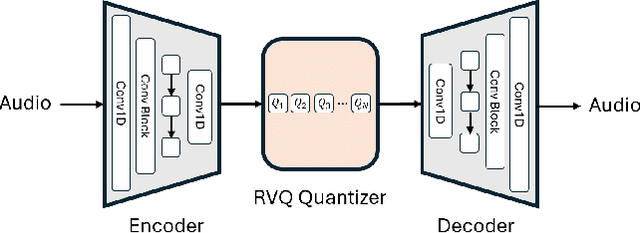
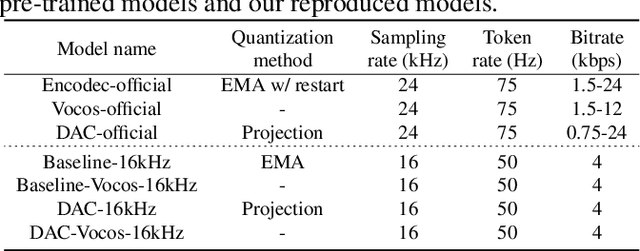
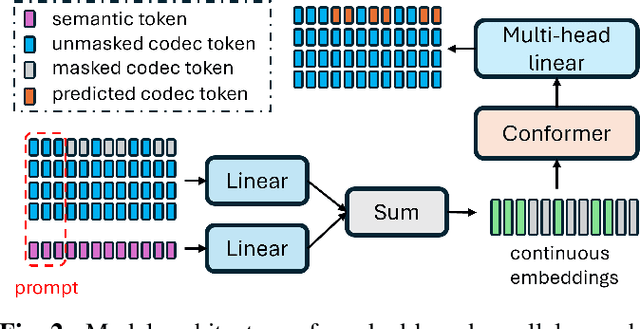
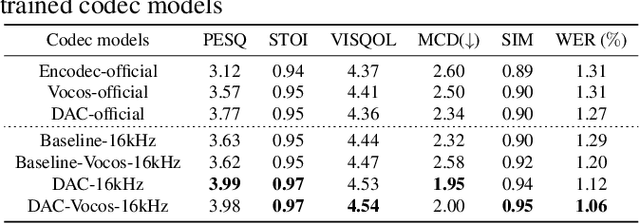
Abstract:Neural audio codec tokens serve as the fundamental building blocks for speech language model (SLM)-based speech generation. However, there is no systematic understanding on how the codec system affects the speech generation performance of the SLM. In this work, we examine codec tokens within SLM framework for speech generation to provide insights for effective codec design. We retrain existing high-performing neural codec models on the same data set and loss functions to compare their performance in a uniform setting. We integrate codec tokens into two SLM systems: masked-based parallel speech generation system and an auto-regressive (AR) plus non-auto-regressive (NAR) model-based system. Our findings indicate that better speech reconstruction in codec systems does not guarantee improved speech generation in SLM. A high-quality codec decoder is crucial for natural speech production in SLM, while speech intelligibility depends more on quantization mechanism.
VALL-E 2: Neural Codec Language Models are Human Parity Zero-Shot Text to Speech Synthesizers
Jun 08, 2024Abstract:This paper introduces VALL-E 2, the latest advancement in neural codec language models that marks a milestone in zero-shot text-to-speech synthesis (TTS), achieving human parity for the first time. Based on its predecessor, VALL-E, the new iteration introduces two significant enhancements: Repetition Aware Sampling refines the original nucleus sampling process by accounting for token repetition in the decoding history. It not only stabilizes the decoding but also circumvents the infinite loop issue. Grouped Code Modeling organizes codec codes into groups to effectively shorten the sequence length, which not only boosts inference speed but also addresses the challenges of long sequence modeling. Our experiments on the LibriSpeech and VCTK datasets show that VALL-E 2 surpasses previous systems in speech robustness, naturalness, and speaker similarity. It is the first of its kind to reach human parity on these benchmarks. Moreover, VALL-E 2 consistently synthesizes high-quality speech, even for sentences that are traditionally challenging due to their complexity or repetitive phrases. The advantages of this work could contribute to valuable endeavors, such as generating speech for individuals with aphasia or people with amyotrophic lateral sclerosis. Demos of VALL-E 2 will be posted to https://aka.ms/valle2.
TransVIP: Speech to Speech Translation System with Voice and Isochrony Preservation
May 28, 2024Abstract:There is a rising interest and trend in research towards directly translating speech from one language to another, known as end-to-end speech-to-speech translation. However, most end-to-end models struggle to outperform cascade models, i.e., a pipeline framework by concatenating speech recognition, machine translation and text-to-speech models. The primary challenges stem from the inherent complexities involved in direct translation tasks and the scarcity of data. In this study, we introduce a novel model framework TransVIP that leverages diverse datasets in a cascade fashion yet facilitates end-to-end inference through joint probability. Furthermore, we propose two separated encoders to preserve the speaker's voice characteristics and isochrony from the source speech during the translation process, making it highly suitable for scenarios such as video dubbing. Our experiments on the French-English language pair demonstrate that our model outperforms the current state-of-the-art speech-to-speech translation model.
CoVoMix: Advancing Zero-Shot Speech Generation for Human-like Multi-talker Conversations
Apr 10, 2024



Abstract:Recent advancements in zero-shot text-to-speech (TTS) modeling have led to significant strides in generating high-fidelity and diverse speech. However, dialogue generation, along with achieving human-like naturalness in speech, continues to be a challenge in the field. In this paper, we introduce CoVoMix: Conversational Voice Mixture Generation, a novel model for zero-shot, human-like, multi-speaker, multi-round dialogue speech generation. CoVoMix is capable of first converting dialogue text into multiple streams of discrete tokens, with each token stream representing semantic information for individual talkers. These token streams are then fed into a flow-matching based acoustic model to generate mixed mel-spectrograms. Finally, the speech waveforms are produced using a HiFi-GAN model. Furthermore, we devise a comprehensive set of metrics for measuring the effectiveness of dialogue modeling and generation. Our experimental results show that CoVoMix can generate dialogues that are not only human-like in their naturalness and coherence but also involve multiple talkers engaging in multiple rounds of conversation. These dialogues, generated within a single channel, are characterized by seamless speech transitions, including overlapping speech, and appropriate paralinguistic behaviors such as laughter. Audio samples are available at https://aka.ms/covomix.
Diffusion Conditional Expectation Model for Efficient and Robust Target Speech Extraction
Sep 25, 2023Abstract:Target Speech Extraction (TSE) is a crucial task in speech processing that focuses on isolating the clean speech of a specific speaker from complex mixtures. While discriminative methods are commonly used for TSE, they can introduce distortion in terms of speech perception quality. On the other hand, generative approaches, particularly diffusion-based methods, can enhance speech quality perceptually but suffer from slower inference speed. We propose an efficient generative approach named Diffusion Conditional Expectation Model (DCEM) for TSE. It can handle multi- and single-speaker scenarios in both noisy and clean conditions. Additionally, we introduce Regenerate-DCEM (R-DCEM) that can regenerate and optimize speech quality based on pre-processed speech from a discriminative model. Our method outperforms conventional methods in terms of both intrusive and non-intrusive metrics and demonstrates notable strengths in inference efficiency and robustness to unseen tasks. Audio examples are available online (https://vivian556123.github.io/dcem).
Adapting Large Language Model with Speech for Fully Formatted End-to-End Speech Recognition
Aug 03, 2023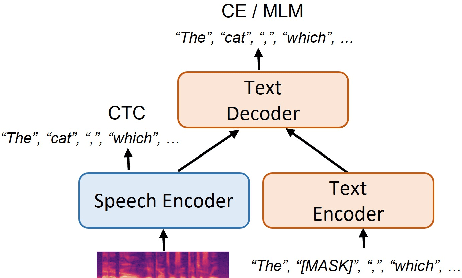
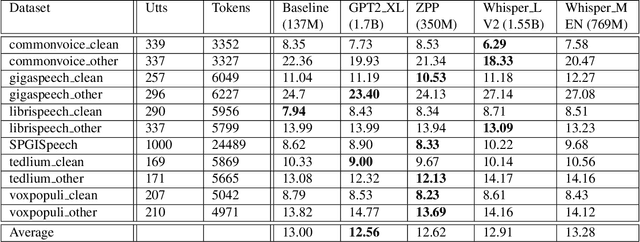
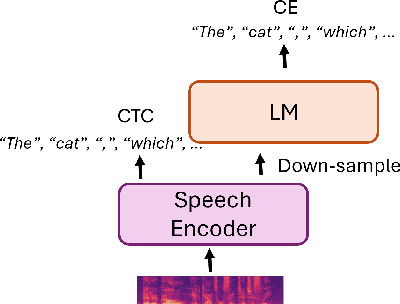

Abstract:Most end-to-end (E2E) speech recognition models are composed of encoder and decoder blocks that perform acoustic and language modeling functions. Pretrained large language models (LLMs) have the potential to improve the performance of E2E ASR. However, integrating a pretrained language model into an E2E speech recognition model has shown limited benefits due to the mismatches between text-based LLMs and those used in E2E ASR. In this paper, we explore an alternative approach by adapting a pretrained LLMs to speech. Our experiments on fully-formatted E2E ASR transcription tasks across various domains demonstrate that our approach can effectively leverage the strengths of pretrained LLMs to produce more readable ASR transcriptions. Our model, which is based on the pretrained large language models with either an encoder-decoder or decoder-only structure, surpasses strong ASR models such as Whisper, in terms of recognition error rate, considering formats like punctuation and capitalization as well.
Adapting Multi-Lingual ASR Models for Handling Multiple Talkers
May 30, 2023



Abstract:State-of-the-art large-scale universal speech models (USMs) show a decent automatic speech recognition (ASR) performance across multiple domains and languages. However, it remains a challenge for these models to recognize overlapped speech, which is often seen in meeting conversations. We propose an approach to adapt USMs for multi-talker ASR. We first develop an enhanced version of serialized output training to jointly perform multi-talker ASR and utterance timestamp prediction. That is, we predict the ASR hypotheses for all speakers, count the speakers, and estimate the utterance timestamps at the same time. We further introduce a lightweight adapter module to maintain the multilingual property of the USMs even when we perform the adaptation with only a single language. Experimental results obtained using the AMI and AliMeeting corpora show that our proposed approach effectively transfers the USMs to a strong multilingual multi-talker ASR model with timestamp prediction capability.
ComSL: A Composite Speech-Language Model for End-to-End Speech-to-Text Translation
May 24, 2023



Abstract:Joint speech-language training is challenging due to the large demand for training data and GPU consumption, as well as the modality gap between speech and language. We present ComSL, a speech-language model built atop a composite architecture of public pretrained speech-only and language-only models and optimized data-efficiently for spoken language tasks. Particularly, we propose to incorporate cross-modality learning into transfer learning and conduct them simultaneously for downstream tasks in a multi-task learning manner. Our approach has demonstrated effectiveness in end-to-end speech-to-text translation tasks, achieving a new state-of-the-art average BLEU score of 31.5 on the multilingual speech to English text translation task for 21 languages, as measured on the public CoVoST2 evaluation set.
i-Code Studio: A Configurable and Composable Framework for Integrative AI
May 23, 2023



Abstract:Artificial General Intelligence (AGI) requires comprehensive understanding and generation capabilities for a variety of tasks spanning different modalities and functionalities. Integrative AI is one important direction to approach AGI, through combining multiple models to tackle complex multimodal tasks. However, there is a lack of a flexible and composable platform to facilitate efficient and effective model composition and coordination. In this paper, we propose the i-Code Studio, a configurable and composable framework for Integrative AI. The i-Code Studio orchestrates multiple pre-trained models in a finetuning-free fashion to conduct complex multimodal tasks. Instead of simple model composition, the i-Code Studio provides an integrative, flexible, and composable setting for developers to quickly and easily compose cutting-edge services and technologies tailored to their specific requirements. The i-Code Studio achieves impressive results on a variety of zero-shot multimodal tasks, such as video-to-text retrieval, speech-to-speech translation, and visual question answering. We also demonstrate how to quickly build a multimodal agent based on the i-Code Studio that can communicate and personalize for users.
 Add to Chrome
Add to Chrome Add to Firefox
Add to Firefox Add to Edge
Add to Edge